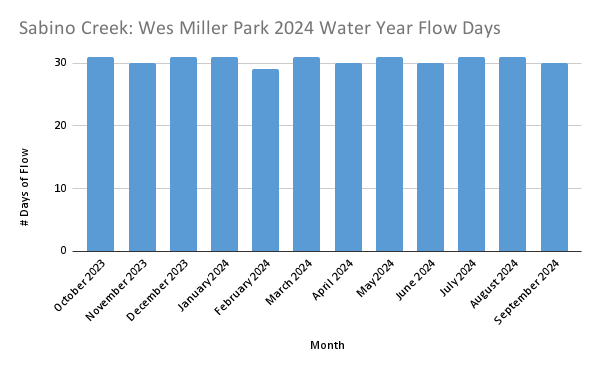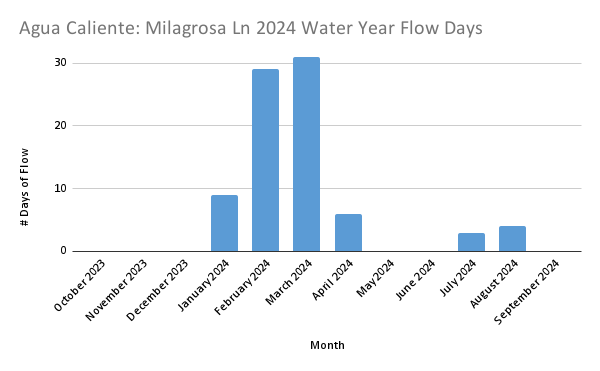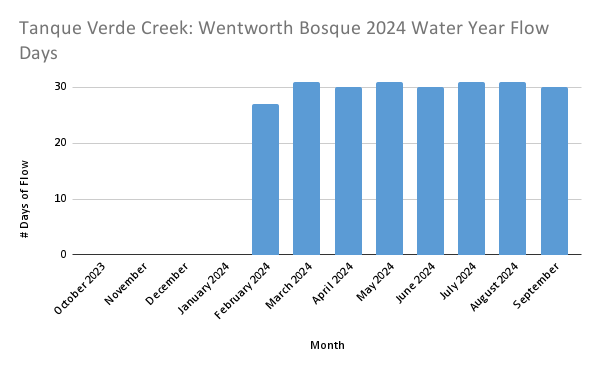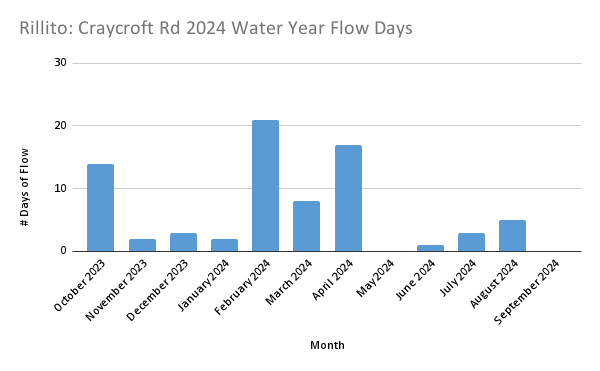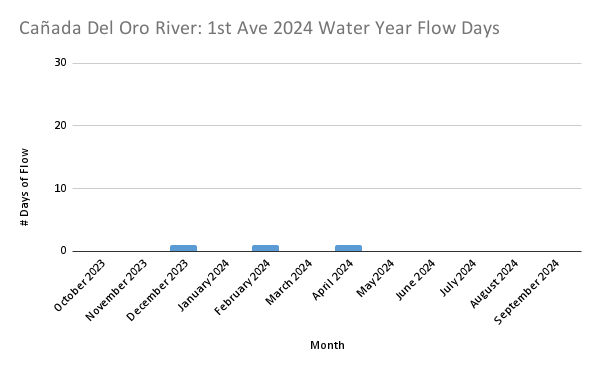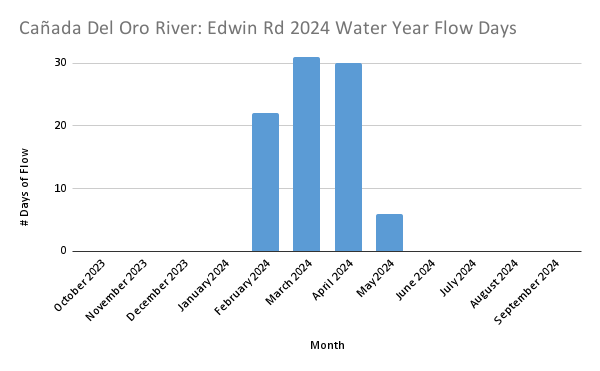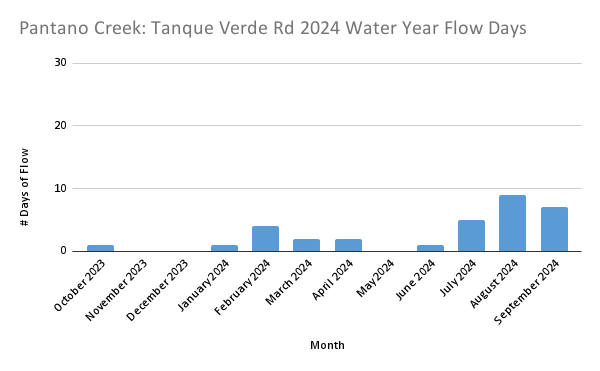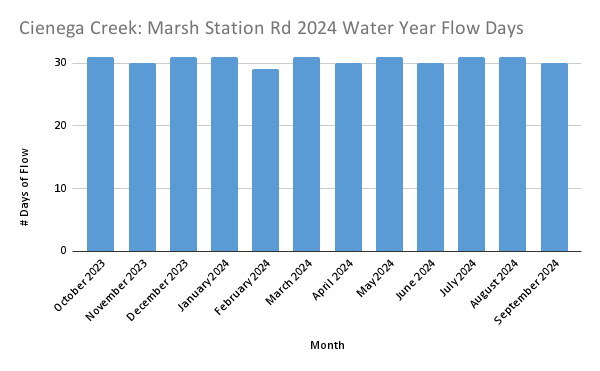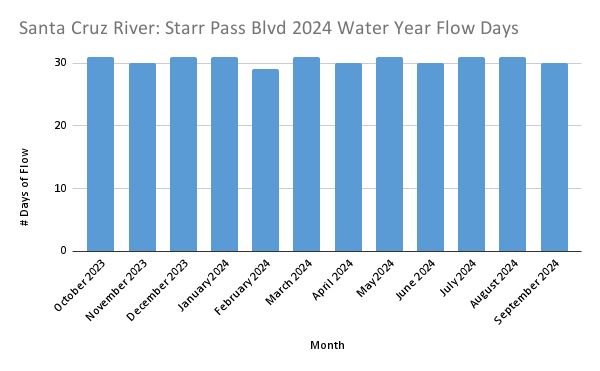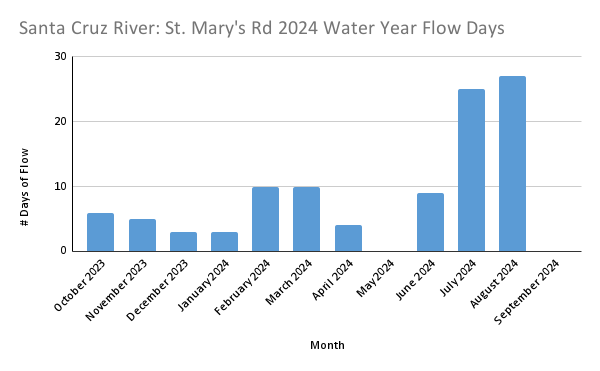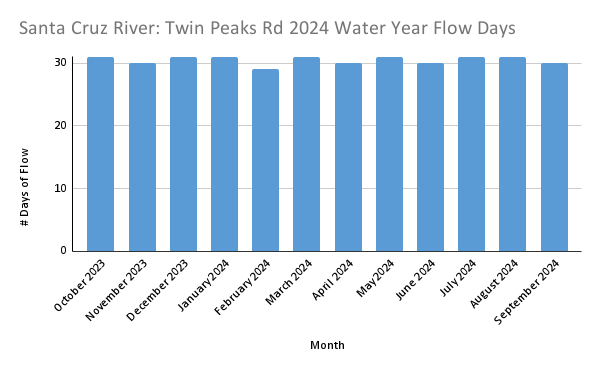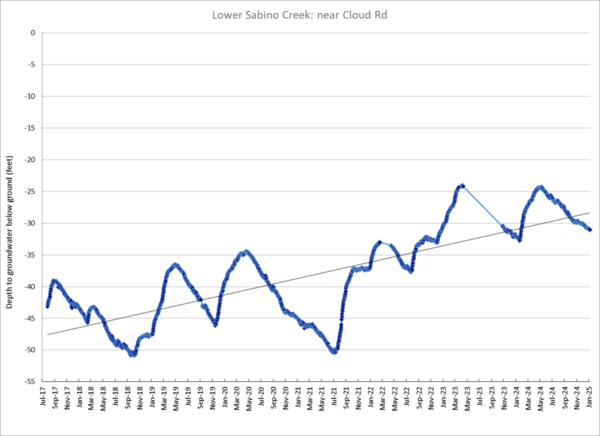Summary of 2024 Water Year: October 1st, 2023 – September 30th, 2024
This year’s flow data indicates we recorded less flow days overall when we compare to the 2023 water year, but with much of the rain occurring in the first 6 months of the 2024 calendar year, many of our rivers still experienced flow on some level. Many of the sites highlighted in this report had decreased flow through our monsoon season, even with an average amount of monsoon rain. We also saw some of our more intermittent sites, like the Wentworth Bosque along the Tanque Verde Creek, began flowing with winter rains in early February 2024 and continued throughout the rest of the water year, which is very unique to this area and its connection to groundwater.
In the 2024 calendar year, the Tucson metro area received 11.52” of rain (NOAA) compared to our 10.61” average; receiving 9.77” of that rain between January 1st and July 31st and only 1.75” in the latter half of the year. The monsoon season was the 3rd hottest on record but with an above average rainfall total of 5.80”. Interestingly, Mount Lemmon received less than average rainfall which may explain less streamflow over the 2024 summer monsoon season for several of the creeks and rivers dependent on mountain flows.
All year long the 92 community scientists in our Flow365 program were capturing flow data for 46 sites across specific streams throughout the Tucson basin. This community science operation is led by trained volunteers from our River Run Network— a group of community members working together to restore Tucson's heritage of flowing creeks and rivers.
Methodology
While agencies such as Pima County Regional Flood Control and U.S. Geological Survey have flow gauges at several locations across Tucson to be able to alert the public about flooding, the data our Flow365 Monitors have been collecting since 2016 fills a gap in this data by recording water presence during lower flows and at more locations. Our program helps capture when flow (presence of water) starts and stops at different times of year and helps us understand the unique nature of our desert rivers, including how they respond to changes in precipitation and groundwater levels.
Our Flow365 Monitors collect data at least once a month, but often weekly or even daily during periods of changing flow. Because of this consistent data collection, we are able to correlate the flows in our creeks and rivers with rain and snowfall, painting a more complete picture of the health of Tucson’s creeks and rivers.
The Flow365 data set can inform local drought triggers and drought response as well as informing climate resilience strategies. Over time, this data also helps us determine the impact of collective conservation actions on creek flow as we strive towards our long-term goal of restoring Tucson’s heritage of flowing creeks and rivers.
In this 2024 water year report we highlight data trends from our Flow365 Monitors including the Santa Cruz River at St. Mary’s Rd and at Twin Peaks Rd, Agua Caliente Creek at Milagrosa Ln, Pantano Creek at Tanque Verde Rd, the Cañada Del Oro River at Edwin Rd and Ciénega Creek at Marsh Station Rd.
This data is used to support the Santa Cruz Watershed Collaborative’s (SCWC) Watershed Restoration Plan and tracking of watershed health indicators.(1) The data collected by the Flow365 Monitoring Program is also correlated with the 2100 One Water Plan(2) and Tucson’s Climate Resilience Plan(3), working to support the goals of these programs and supporting their outcomes.
(1) Santa Cruz Watershed Collaborative: People working together to ensure a natural heritage of healthy urban watersheds with flowing rivers and creeks.
(2) 2100 One Water Plan: The One Water approach treats all water resources as equally important, including surface water, groundwater, recycled water, and rain and stormwater harvesting.
(3) Tucson’s Climate Resilience Plan: The Climate Action Plan—known as Tucson Resilient Together—will provide a strategic pathway to reduce the City’s emissions to net zero by 2030, explain the anticipated impacts of climate change across the City, identify the communities that will be most vulnerable to those impacts, and provide strategies that will assure that Tucson can adapt and be resilient to the impacts of climate change – now and in the future.
We also have a shortened version of this report available as a PDF. You can view and download the PDF here.
Sabino Creek
Our Monitors observe several sites at the base of the Catalina Mountains. On the east side of Tucson, they capture data from Bear Creek and Lower Sabino Creek. These creeks start in the mountains, with rain and snowmelt feeding surface flows. When the creeks move into the valley, there are some places where shallow groundwater aquifers also support surface flow in addition to rain and snowmelt, however, we are concerned about reduction in flow at the particular site mentioned in this report.
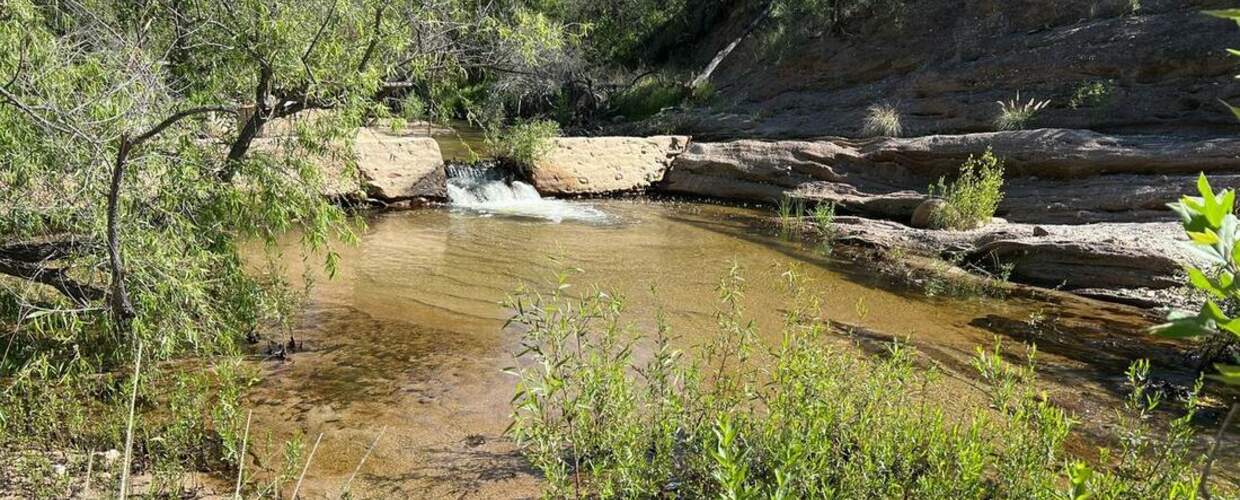
Most of Lower Sabino Creek is privately owned by residential landowners. We have captured data since the start of our program with permission from the surrounding private landowners and the homeowners associations who use and preserve this area. The restored perennial flow that we observed from 2016 to 2022 is likely the result of a reduction in groundwater pumping at several nearby groundwater wells.
However, Wendy Beall, the Flow365 Monitor in the area, started to observe lower level flows (mostly ponding) in mid-August 2023 (last Water Year). This is highly unusual for this site as we have not seen this since the Flow365 Monitoring Program began in 2016. These lower levels continued until our winter rains picked back up in December 2023 (this Water Year), and we have continued to see consistent water movement at low flow (level 3) since then.
Agua Caliente Creek
North of Tanque Verde Creek, at the foot of the Catalina Mountains, Agua Caliente Creek runs just west of Agua Caliente Park and eventually meets up with Tanque Verde Creek. Our Flow Monitors have revealed that flow in this area is dependent on rain and snowmelt. Though it does not flow year round, data shows short intermittent flows throughout our winter season are sustained by mountain snowmelt runoff. The creek is able to meander freely in much of its floodplain and has more natural flow, unlike some of the channelized rivers in the metro area.
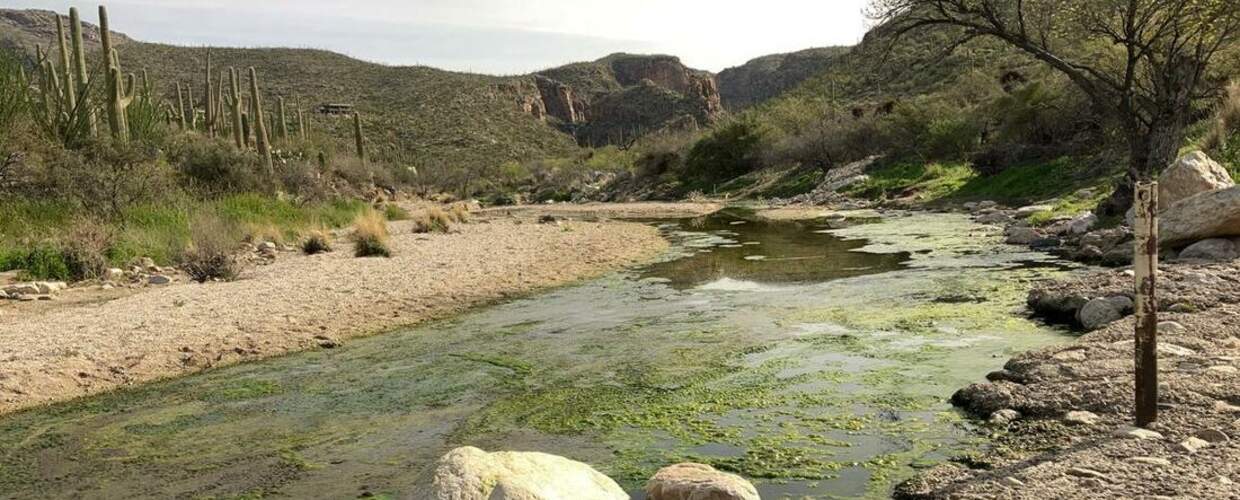
We continue to see this area flourish, experiencing extensive flow during the winter rain season of the 2024 Water Year, a total of 82 days with 75 of them being consecutive, flowing from January 23rd, 2024 to April 6th, 2024. Last year, all of the flow that was observed was due to winter rains, with no flow observed during our monsoon season, due to a decrease in rainfall in that season. This year, however, Flow Monitors recorded 7 days of flow during this monsoon season, even though we only experienced 1.75” in the last half of the year. So, even though we recorded less flow days overall, we recorded flow over a longer span of time in this area, which may mean more groundwater recharge overall.
Tanque Verde Creek
Historically, stretches of the Tanque Verde Creek were often flowing, either seasonally or year-round with marshy cienegas sustained by beaver. But since the mid-1900s, this creek has been drying up with the loss of seasonal and year-round flows due to depleted groundwater levels from over pumping groundwater. This area has one of the few remaining riparian forests with floodplain connection in the Tucson basin, including Fremont cottonwood, Goodding's willow, Mexican elderberry, and velvet mesquite, as well as many other riparian plants native to the Sonoran Desert. Unfortunately, it has more recently become home to an invasive species called Arundo donax, a giant cane reed. This highly flammable reed crowds out native plants, and uses up to 3-4 times the amount of water as native plants, diminishing flow. Through the River Run Network, we are working to remove this species along the Tanque Verde Creek. To date, we have removed invasive Arundo from over 60 acres of the creek. Learn more about our Arundo removal efforts and how to get involved here.
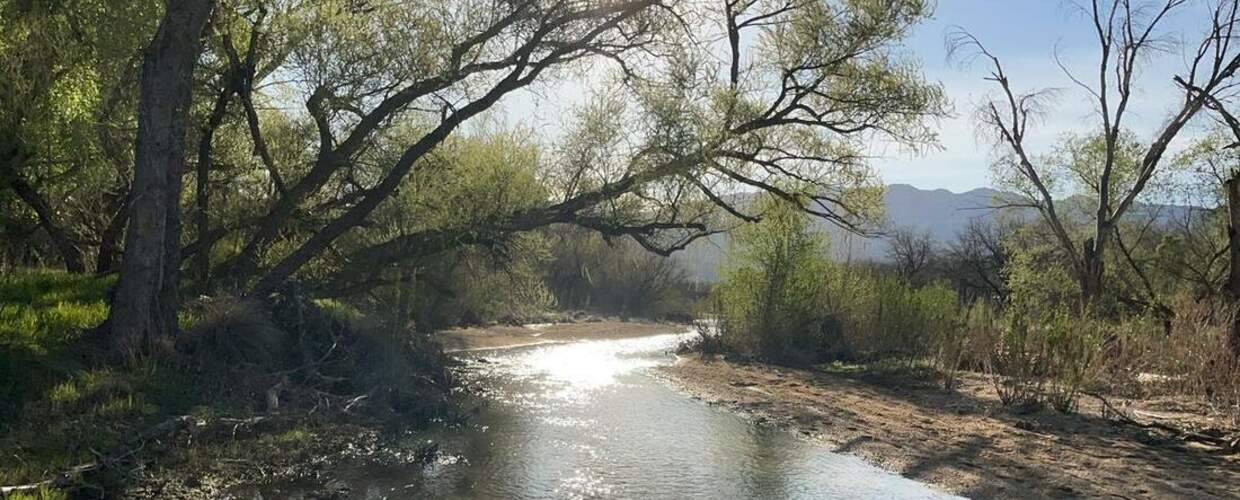
WMG has observed seasonal flows in this area since 2019. Between the 2021 and 2022 Water Years, our Flow Monitors recorded 288 days of consecutive flow (July 23, 2021 - May 6th 2022), a record number that still has not been beaten. The area started flowing on February 3rd, 2024 lasting through the end of the 2024 Water Year (September 30, 2024).
Even with much less rainfall, this area experienced more flow days than in the last Water Year. This tells us that the area has substantial opportunity to continue to see flow days and flow amounts increase over time, even with potentially drier years and less mountain snowmelt runoff due to climate change. More local groundwater recharge efforts, reduced groundwater pumping, and the removal of Arundo donax can continue to enhance flow in this area, as observed by the change in flow between this year and last.
This middle stretch of the Tanque Verde Creek tells an amazing story of resilience and the potential for humans’ impact on restoring flow and shallow groundwater areas. The nearby golf course that was pumping groundwater switched to reclaimed water in 2005, and since then the aquifer and riparian forest has been steadily recovering with seasonal flows emerging. This groundwater recovery has occurred during a time of multi-decadal drought, with many years of less than average rainfall.
Rillito River
Because of The Loop path and many parks along its banks, the Rillito River is popular with the Tucson community as a corridor to walk, run, bike, and picnic. The Rillito River is fed by the Tanque Verde and Pantano Creeks, flowing from east to west, eventually connecting with the Santa Cruz River. The Rillito River is also known for a large bat population, the Mexican free-tailed bats, which live in large colonies under several bridges that cross the river.
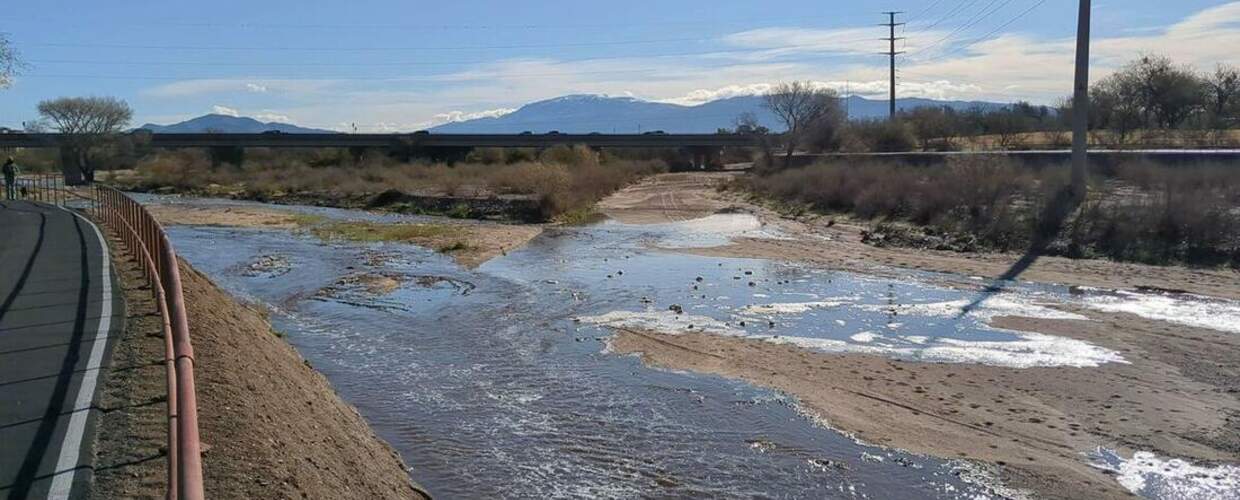
The flow monitors in this area observed a decrease in flow in the 2024 water year, going from 113 days to 76 days and only 25 days of consecutive flow in the early part of the water year. This is most likely due to the lack of rain in the last half of the 2024 calendar year.
This site is the confluence of the Tanque Verde Creek and Pantano Creek and is considered a shallow groundwater area, with water within 50 feet of the surface. The shallow groundwater still supports some cottonwood trees from a historically much larger cottonwood forest, as well as a Mexican elderberry grove upstream of the confluence. Historically, this area had year-round flow through a large ciénega (marsh) with a large mesquite bosque (forest) that supported Indigenous communities.
The presence of cottonwood trees, which need water within 30 feet of the surface to survive, indicates perched aquifers and/or the presence of springs. A rheocrene spring has been documented just upstream of the confluence in the Tanque Verde Creek. These features and suspected groundwater levels continued to be sustained throughout the 2024 Water Year even with a decrease in flow days and rainfall.
Cañada del Oro River
The Cañada del Oro River originates in a remote portion of the Catalina Mountains north of Tucson. Fed by rainfall and melted snow, it flows north toward the town of Oracle and then turns south toward Oro Valley where it is usually seen as a dry riverbed. The Cañada del Oro ultimately feeds into the Santa Cruz River just northwest of the city.
Historically, the Cañada del Oro River was largely intermittent and ephemeral, this means that even without groundwater pumping and floodplain channelization, it only had above ground flow during rainy seasons. However, there are reports that some areas were plentiful with water close to the surface, like at the Steam Pump Ranch in Oro Valley. This means that even though there was no surface flow, much of the Cañada del Oro River could have been considered a shallow groundwater area.

It was a significantly dry year for the Cañada del Oro River, only seeing 3 days of flow at this site instead of 7 days like the 2023 water year. This may be due to the lack of rain in the Catalina Mountain area that drains into this portion of the Cañada del Oro River. We continue to have a robust data set for this area, receiving data on average once a week and sometimes more frequently. With that, we still consider this area ephemeral, only flowing when there is rainfall, and rarely even then. Historically, this area would have been considered intermittent, flowing potentially as often as the Agua Caliente Creek along Milagrosa Ln (see that site profile above): for a short time after the rains subsided, but not flowing year round.

This is the most upstream site we have along the Cañada del Oro River, it is located just miles from the base of the Catalina Mountains in an open range area where we have occasionally seen cattle, deer, and other wildlife roaming and making use of the flow when it is present.
Surrounded by private property and dirt roads, this area is also home to a beautiful mesquite bosque on either side of the creek and close to the Charloux Gap Trail in Catalina, AZ. One monitor has been collecting data on this site for the past two years and has seen the area go from a dusty and dry sandy bed to flowing bank to bank for weeks, supporting this bosque and the wildlife mentioned above.
Pantano Creek
Pantano Creek originates at the confluence of Ciénega Creek and Agua Verde Creek, southeast of Tucson near Vail. Flow is primarily contributed from Ciénega Creek and secondarily through Rincon Creek, which originates east of Tucson near Rincon Peak. Pantano Creek flows north to join with Tanque Verde Creek at Craycroft Rd, becoming the Rillito River. Although it is fed from two creeks with seasonal and perennial flow stretches, this creek rarely flows as the water quickly sinks into the deeper aquifer. Though there is not much flow observed from this creek and it is largely disconnected from its historic floodplain due to concrete bank stabilization, the creek has a beautiful meandering pattern when it does flow, emulating the natural course a desert river takes.
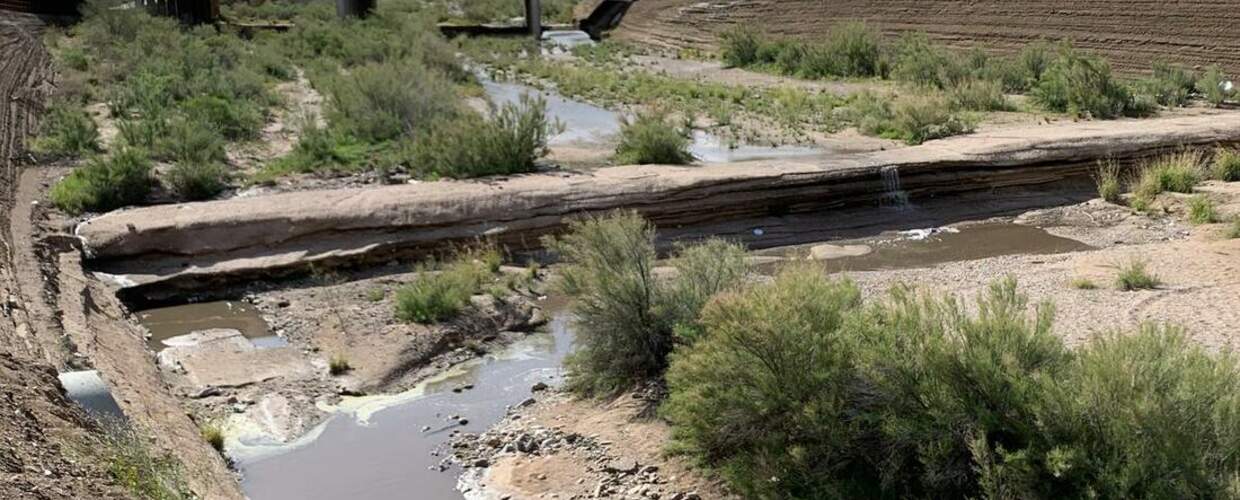
This site is the farthest downstream area we are collecting data along the Pantano Creek, which means it is closest to where the Pantano Creek merges with the Tanque Verde Creek to form the Rillito. Historically, this creek was a marshy wetland area supported by shallow groundwater. Currently, this site sees flow ephemerally and the water table is over 200 feet deep, meaning it flows only in response to precipitation, and rarely even then. This urban site contains a grade control structure similar to the one along the Santa Cruz River and St. Mary’s Rd. This structure also typically creates a long-lasting pond at the base of the structure after a flow event, and is where much of our data on the presence of water comes from for this area.
Ciénega Creek
This creek is perennial in many stretches, and reaches from the base of Mount Wrightson to eventually connect to Pantano Creek. The River Run Network spends quite a bit of time in Ciénega Creek. From restoration workshops in Empire Ranch where we are planting native plants and moving rocks to slow spread and sink flow into the ground, to fence line surveys in the National Conservation Area in the upper reaches to support the reintroduction of beavers, we are always in awe of Ciénega Creek.
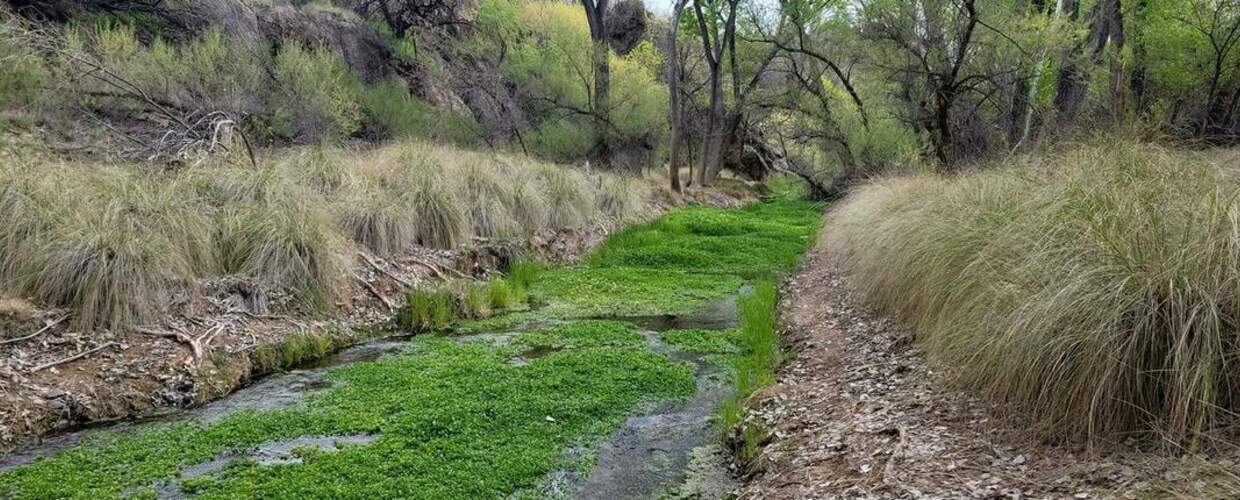
We added another Flow365 Monitor here at the beginning of the 2024 calendar year, so with the collaboration of this team of two volunteers, we continue to see that Ciénega Creek is still flowing year round! It is quite a hike to get to this monitoring spot, the typical visit may take 40 minutes to an hour depending on how quickly one wants to hike. As you make the journey you will experience the transition from upland desert plants like ocotillo and prickly pear cactus, down into the canyon with the cover of riparian plants like large cottonwoods and willows, then to seeing and plants like duckweed floating in the water.This site is an incredible oasis, supporting the idea and possibilities of what many of our other creeks and rivers could look like with consistent flow.
Santa Cruz River
The Santa Cruz River historically flowed year-round until 1941 and was home to many species of native fish, frogs, and other aquatic species. Over time, groundwater pumping caused water levels to decline, changing the flow to ephemeral (flowing only with rainfall) in the 1940s. At present, stretches of the Santa Cruz River flow perennially in Tucson with the input of treated effluent. Many of these projects were developed to recharge water in the aquifer to store for future use. However, having consistent flow in the river has also created a riparian habitat throughout different stretches that can support native fish and provide a necessary resource to other wildlife as well as an amenity that is attractive to surrounding neighborhoods, cyclists, and pedestrians on the Tucson Loop path.
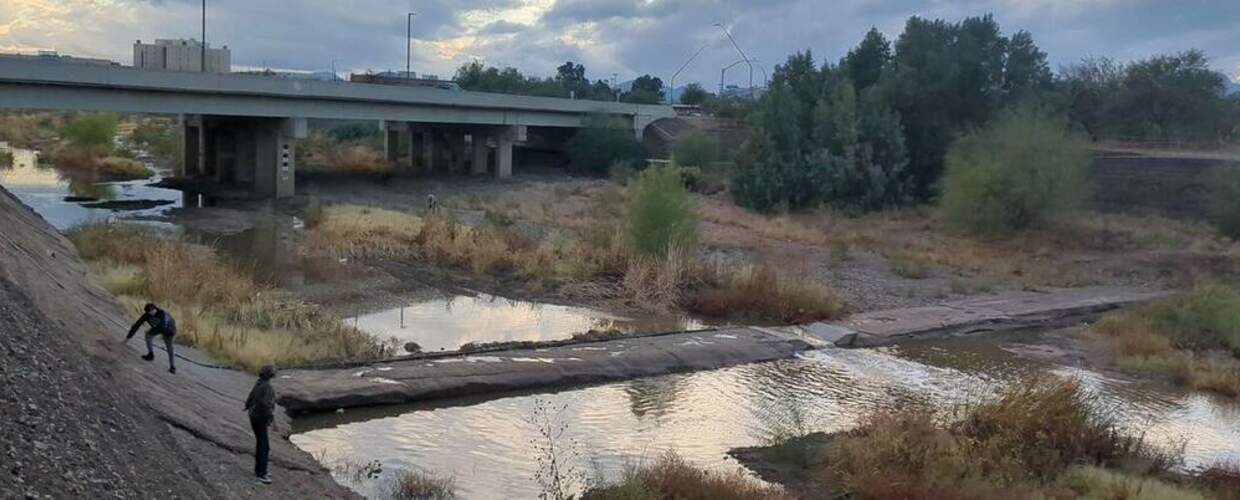
This stretch along the Santa Cruz River has been flowing perennially with the release of effluent flow from the Santa Cruz Heritage Project since 2019. With this release of water, the site has changed quite a bit. From a barren sandy river bed to a blossoming riparian area, the released water has allowed some riparian plants to return, as well as supporting wildlife like fish, frogs, birds, and dragonflies. Our Monitor at this location has captured incredible photos and data to share about its growth and the effect it has on the water flow to downstream sites as well.
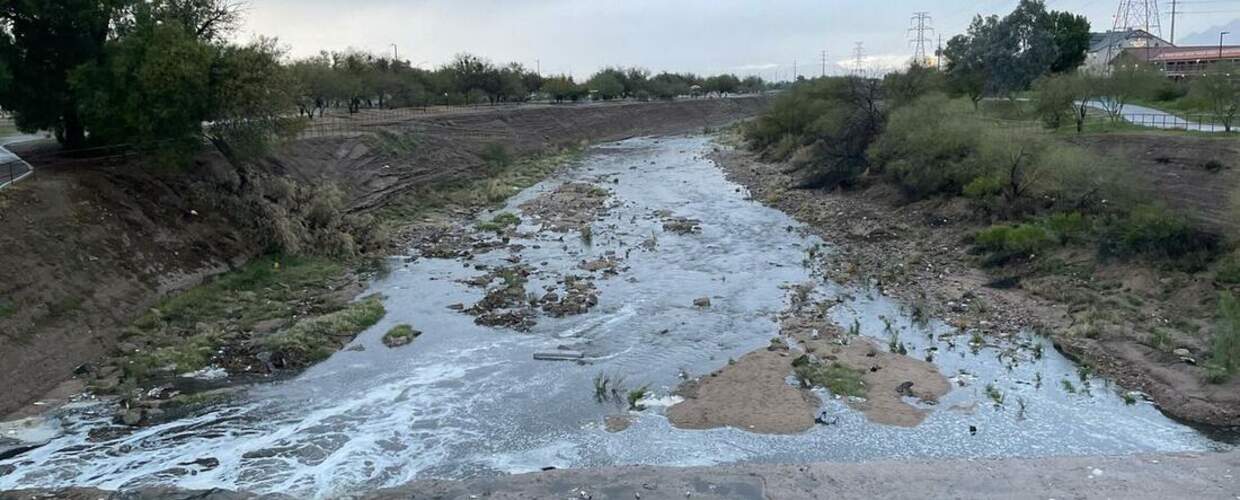
A few streets north, or downstream, along the Santa Cruz River, Flow365 Monitors have been collecting data along St. Mary’s Rd, a site that occasionally experiences flow and connection to the release of water from the Santa Cruz Heritage Project, but not year-round.
The monitoring location is at the bridge over the river overlooking a grade-control structure,which is a large slab of concrete under the bridge that ensures its safety and stability even with large flows that move sediment in the creek bed. This structure, seen in many of the monitoring photos, has a deep scour hole on the north side of the bridge. Water ponding in this scour hole persists for days or weeks after flow has dissipated. This additional water supports many local trees and wildlife.
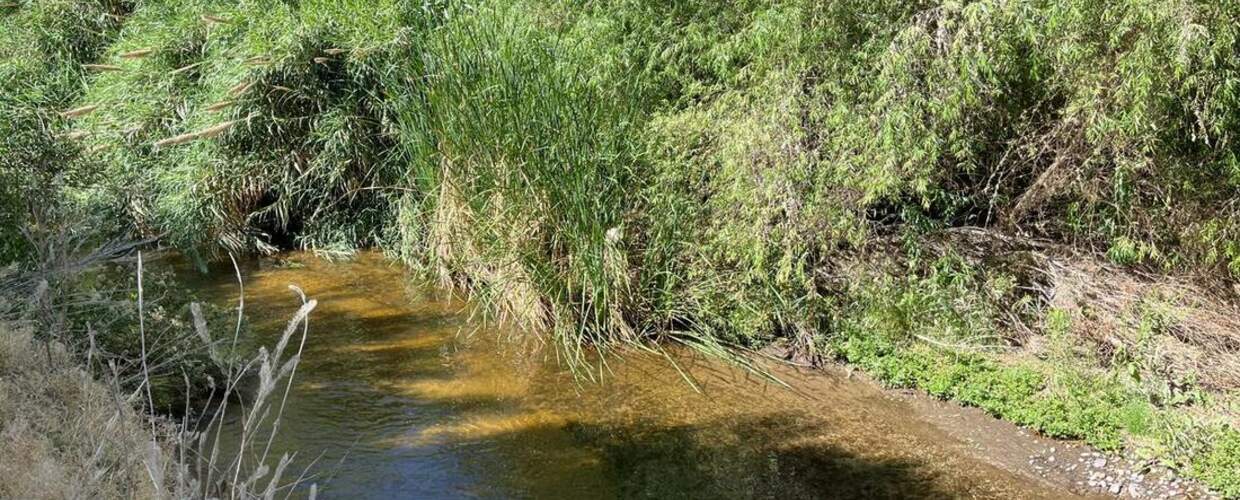
As we continue downstream, we reach Twin Peaks Rd where a single Flow Monitor has been consistently collecting data since 2021. The effluent flow released at Ina Rd reaches here and heads all the way north to Marana, flowing beyond Trico Rd, where we have our northernmost monitoring location along this river. Flow365 Monitor Nancy Grosvenor, often accompanied by her dog, enjoys going down to this site to collect data and explore the area. The portion of the channel is very narrow, but there is still room for fish to swim in the water and you can often see swallows nesting under the bridge.
This site is visited often in our creek walk series “Santa Cruz River Flows,” where the River Run Network invites you to join our staff on a guided walk to explore riparian ecosystems supported by recycled water flow areas along the Santa Cruz River.
Flow365 Underground Well Data
The Flow365 Monitoring Program has been able to record well water data in a few key areas thanks to private well owners. Pairing surface flows and nearby groundwater level data helps to gain a working knowledge of this dynamic hydrologic relationship. Even if many of our creeks and rivers are not flowing on the surface, there is still water flow underground that can be measured through wells. With this data as you’ll see below, we are able to understand just how quickly these areas can respond to slower, gentler flows like snow melt and winter rains and the seasonal and annual trends which support these riparian forests. Currently we have well data from areas along Sabino Creek and Rincon Creek, and we look forward to expanding this portion of the program and collecting more well data thanks to our partnership and sponsorship with Pima County Regional Flood Control District.
The graphs which follow show depth to groundwater, so the top of the vertical axis of these graphs is labeled with a zero. This is the ground surface at the well site. Note that these wells are near the creek and elevated topographically, so it does not state the depth to water below the channel. These negative numbers represent how far below the ground surface the water level is. In both of these wells’ historical data, you can see that there is a general upward trend over the years of water levels being closer to the surface. This may indicate that these wells are recording a gradual recovery of the aquifer in these areas over many years.
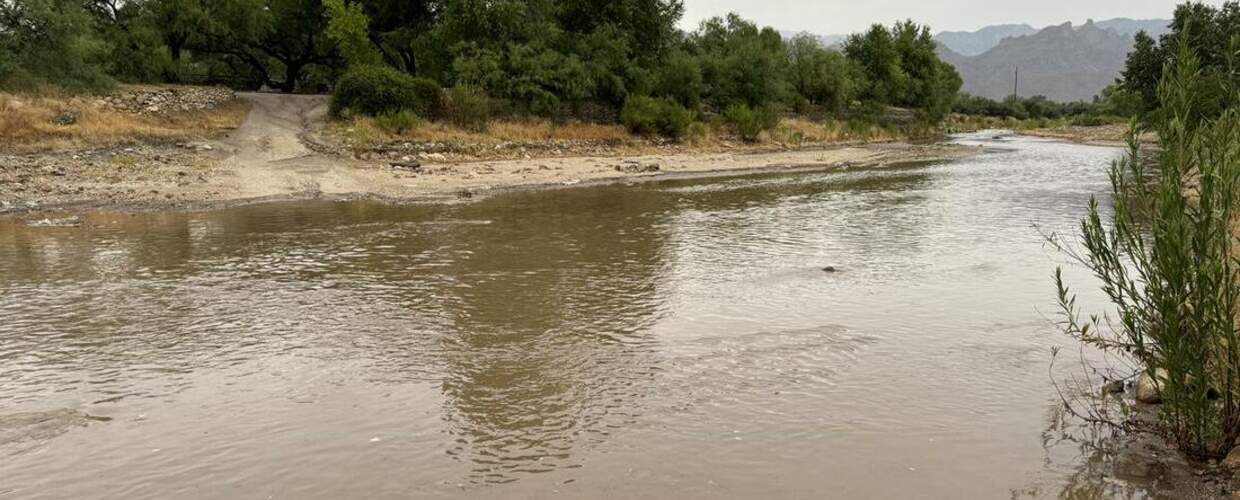
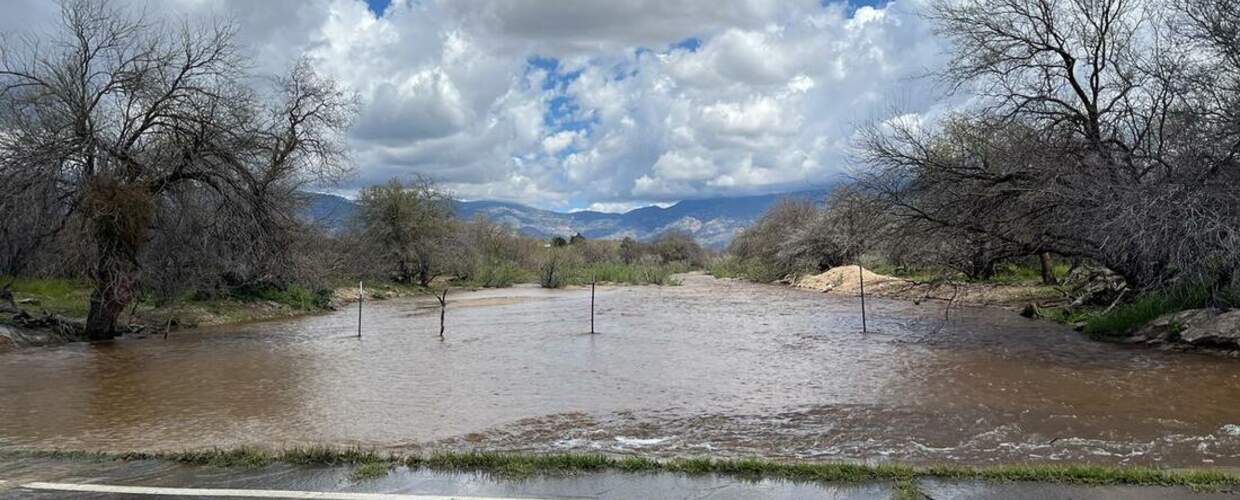
Thank you for reading our Flow365 Annual Report, we look forward to gathering more data and presenting reports in the years to come.
